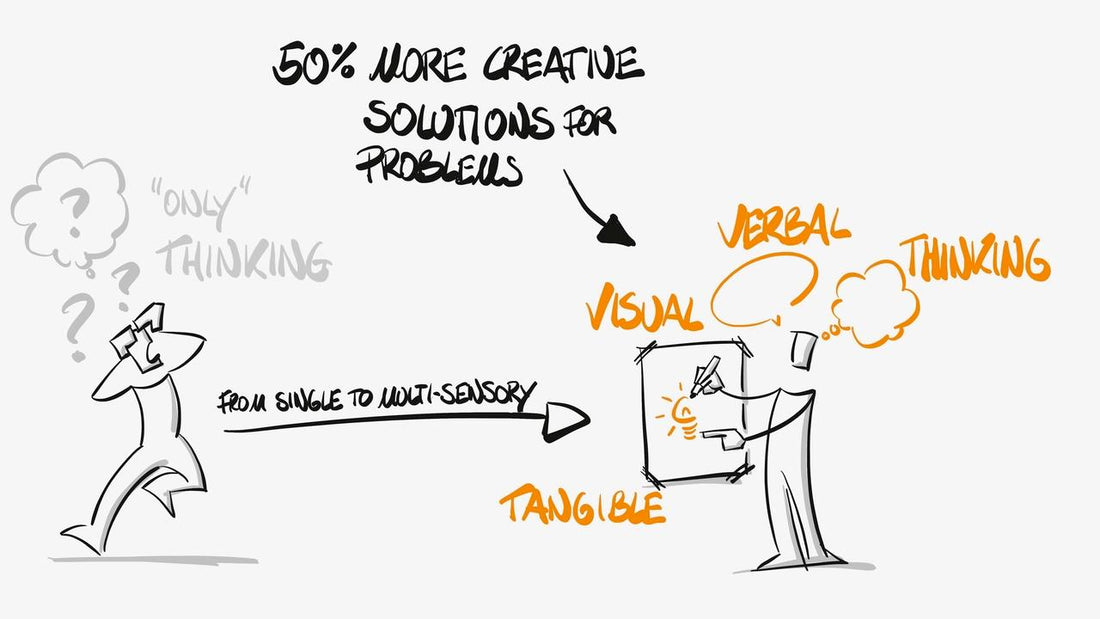Have you ever had the experience of thinking about a problem all the time, so that you can’t even sleep because it won’t let you go, even in the middle of the night?
The problem is too complicated. Each time one door to a solution starts to open, another two doors are closing.
The solution seems near, but every time you think it through it slips away…
You are starting to get a headache from thinking about it!
Sound familiar? I've been there often enough.
And yet, I would argue that you can overcome this hurdle with a time investment of only 5 minutes! Seriously - that should be plenty. As I'm working on the materials for my workshops and keynotes, I wanted to share this concept with you.
The big hurdle is the way we typically approach the problem-solving process. I call this your design brief. The design brief is the way you help yourself understand your issue. Without understanding your problem clearly, the solution will be hard to find.
Very often, we adopt a single-sensory approach. For example, you only think about or talk about the problem. By restricting yourself to a single sense, you limit the number of possible avenues to a solution.
According to a study by the educational psychologist, Richard E. Mayer problem solving can be enhanced by using a multi-sensory approach.
In the study, Mayer found that a group of participants who receive a multi-sensory design brief (visual, verbal, hands-on and connected to more than just a screen) will create 50% more creative solutions to a problem-solving test than a group who receive a single-sensory design brief.

So how can you put this insight to work on your own problem?
If you are struggling to solve the difficult problem that keeps you awake at night, stop just thinking or talking about it. That's single-sensory input for yourself.
Instead, by taking a piece of paper, writing your thoughts down, drawing some connecting arrows or creating a diagram, you can create a multi-sensory design brief for yourself. This will dramatically increase your chances of finding a creative solution to your problem.
Here’s how to do it:
- Take a pen and a piece of paper.
- Don't write a list! Write the elements of your problem distributed on your page. The first element would be the topic. The following elements could be descriptions of parts of the problem like future investments and what these investments look like etc.
- Leave plenty of space between these first words.
- After writing the first 3-5 words down, start adding more elements of your problem near to where they belong on the paper.
- If you can, connect the words with arrows, or cluster them with boxes. Adding these visuals to your thought process will help you understand the big picture better.
- Can you even draw some simple icons to add to the words? If not, stick to boxes and arrows.
- Stop.
- Take a 30-second break
- Look at the page again. What do you notice?
- Now start thinking about solutions, by writing and sketching them on a new sheet of paper.
- As with the problem, don't write the possible solutions as a list - spread the words on the paper, and use arrows, boxes and/or icons to make connections and show relationships.
- For finding creative solutions you can have plenty of tools at hand to trigger your creativity. What I like most is the very simple approach of trying to "draw" the same picture like before, but without the problem elements. Instead of those problem elements, you fill in your ideas for a solution.
As we just wanted to "unlock" your problem, the solution finding will get a separate blog post. :)
By going through this process, you are creating a multi-sensory design brief, enhancing your problem-to-solution process.
It's surprisingly easy to trick yourself into this mode and switch on creative connections in your brain. The crucial part is getting your thoughts out of your head. Quickly.
If you struggle to find a workable solution the first time you try this, don't worry. The habit of doing it more often will help you over time!
If you would like to learn more about this and other visual tools and get my help in putting them into practice, you can join my email list or contact me directly at mail(at)holgernilspohl.com




2 comments
Hey Nils, just wanted to say I really found this article very helpful. It’s a great approach and I am looking forward to putting it into practice. I especially like the ‘not putting things in a list’ concept. In so doing, we probably hugely reduce the range of solutions we can conceptualise because we impose an apparent order or structure on the ideas, but lose the really powerful bit which is connections between concepts – and the way they interrelate. Well done.
Brilliant and great way to quickly visualize where things are blocked ! Thanks Holger